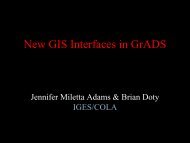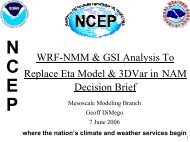The NCEP Climate Forecast System Reanalysis - NOAA National ...
The NCEP Climate Forecast System Reanalysis - NOAA National ...
The NCEP Climate Forecast System Reanalysis - NOAA National ...
Create successful ePaper yourself
Turn your PDF publications into a flip-book with our unique Google optimized e-Paper software.
following the subgrid-scale orographic drag parameterization by Lott and Miller (1997). Atwo-layer sea-ice model (Wu et al., 2005) is also part of the current operational GFS AMand the model now uses the Earth <strong>System</strong> Modeling Framework (ESMF) base moderncomputer algorithms (Collins et al., 2005). Update of the ozone production and destructionterms is done by using the monthly mean data provided by NRL (McCormack et al., 2006).<strong>The</strong> horizontal resolution is T382 with 64 hybrid vertical layers with the top layer ~ 0.2 hPa.<strong>The</strong> vertical structure of the model levels for the 28 sigma layer model (left panels) used inR1 and the 64 layer sigma-pressure hybrid model (right panels) used in the GFS/CFSR isshown in Figure 30 as a cross section at 90E, and as a cross section across North America at40N in Figure 31. <strong>The</strong> top panels in both figures are plotted as a function of pressure toemphasize the resolution in the troposphere. In the bottom panels, the vertical axis islog(pressure) to emphasize the stratosphere. It can be seen that the new vertical structureadds more resolution in the stratosphere and does not have the topography signature above100 hPa.<strong>The</strong> version of GFS AM used in the CFSR has additional changes. It now uses enthalpy(CpT) as a prognostic variable in place of virtual temperature (Akmaev and Juang, 2008,Juang 2009) with a generalized hybrid vertical coordinate with sigma-pressure option. <strong>The</strong>vertical discretization is based on the generalized hybrid vertical coordinate (Juang, 2005). Italso uses RRTM shortwave radiation with maximum random cloud overlap (Iacono et al.,2000; Clough et al., 2005) and a simple modification of shallow convection/vertical eddydiffusion parameterizations that helps in improving marine stratus prediction off the westcoasts of continents. In the following, some details on some of the newer features of themodel are provided.3.2.1 Upgrades to Radiation Parameterization<strong>The</strong> new LW and SW radiation parameterizations are modified GCM versions(v2.3g_LW and v2.3g_SW) of the Rapid Radiative Transfer Model (RRTM) (hereafterreferred to as RRTMG-LW and RRTMG_SW) adapted from AER Inc. (e.g. Mlawer et al.,1997; Iacono et al., 2000; Clough et al., 2005). In the CFSR implementation we invoke both- 25 -





